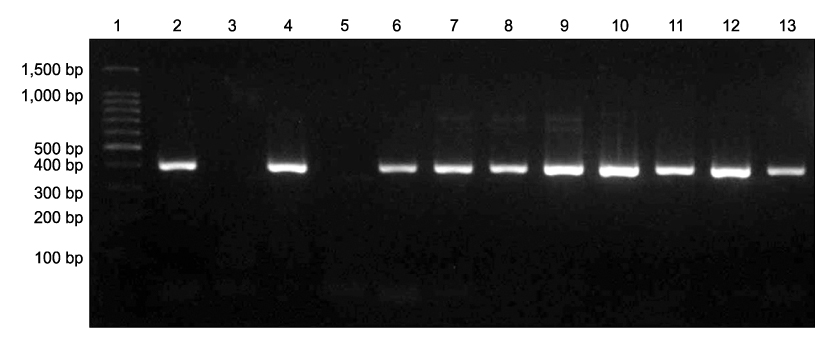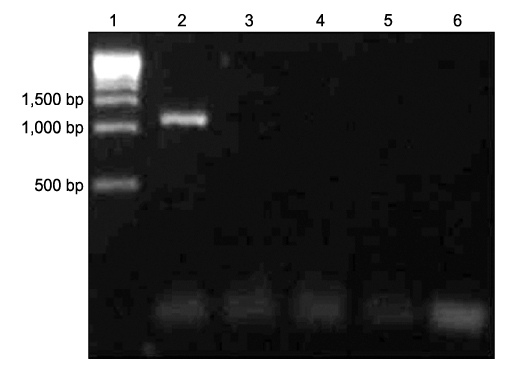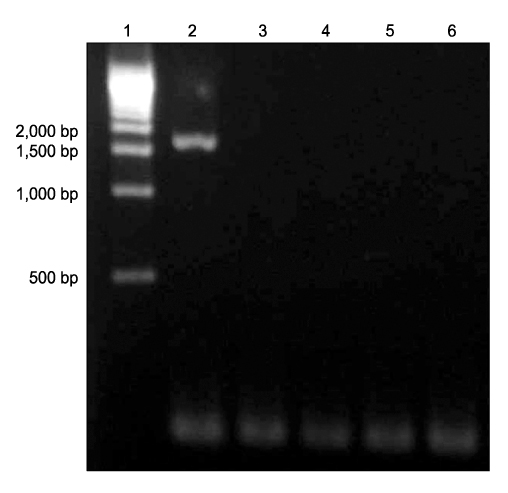J Vet Sci.
2009 Mar;10(1):67-72. 10.4142/jvs.2009.10.1.67.
Survey of Helicobacter infection in domestic and feral cats in Korea
- Affiliations
-
- 1Department of Veterinary Internal Medicine, College of Veterinary Medicine, Seoul National University, Seoul 151-742, Korea. cyhwang@snu.ac.kr
- 2KRF Priority Zoonotic Disease Research Institute, College of Veterinary Medicine, Seoul National University, Seoul 151-742, Korea.
- 3BK21 Program of Integrative Network Systems for Veterinarians in Basic Science, Industrial Animals and Preventive Medicine, Konkuk University, Seoul 143-701, Korea.
- KMID: 1089348
- DOI: http://doi.org/10.4142/jvs.2009.10.1.67
Abstract
- Discovery of Helicobacter (H.) pylori has led to a fundamental change in our understanding of gastric diseases in humans. Previous studies have found various Helicobacter spp. in dogs and cats, and pets have been questioned as a zoonotic carrier. The present study surveyed the Helicobacter infections and investigated the presence of H. felis and H. pylori infections in domestic and feral cats in Korea. Sixty-four domestic cats and 101 feral cats were selected from an animal shelter. Saliva and feces were evaluated by Helicobacter genus-specific polymerase chain reaction (PCR). Genus-specific PCR positive samples were further evaluated for H. felis and H. pylori using specific primer pairs. Thirty-six of 64 (56.3%) samples from domestic cats and 92 of 101 (91.1%) samples from feral cats were PCR positive; the positive rate of feces samples was higher than that of saliva samples in both groups. H. felis and H. pylori species-specific PCR was uniformly negative. The prevalence of Helicobacter spp. in feral cats was approximately two-fold higher than that of domestic cats. The fecal-oral route may be more a common transmission route not only between cats but also in humans.
Keyword
MeSH Terms
-
Animals
Cat Diseases/*epidemiology
Cats
DNA, Bacterial/genetics
Feces/microbiology
Helicobacter Infections/epidemiology/microbiology/*veterinary
Helicobacter felis/genetics/isolation & purification
Helicobacter pylori/genetics/isolation & purification
Korea/epidemiology
Polymerase Chain Reaction/veterinary
Saliva/microbiology
Species Specificity
Figure
Reference
-
1. An JH, Nam HW, Han JH, Kim D. The detection of Helicobacter-like organisms in dogs. Korean J Vet Clin Med. 1999. 16:281–288.2. Axon ATR. Is Helicobacter pylori transmitted by the gastro-oral route? Aliment Pharmacol Ther. 1995. 9:585–588.3. Boomkens SY, Kusters JG, Hoffmann G, Pot RGJ, Spee B, Penning LC, Egberink HF, Van den Ingh TS, Rothuizen J. Detection of Helicobacter pylori in bile of cats. FEMS Immunol Med Microbiol. 2004. 42:307–311.4. Brown LM. Helicobacter pylori: epidemiology and routes of transmission. Epidemiol Rev. 2000. 22:283–297.5. Chisholm SA, Owen RJ. Development and application of a novel screening PCR assay for direct detection of 'Helicobacter heilmannii'-like organisms in human gastric biopsies in Southeast England. Diagn Microbiol Infect Dis. 2003. 46:1–7.
Article6. De Schryver A, Van Winckel M, Cornelis K, Moens G, Devlies G, De Backer G. Helicobacter pylori infection: further evidence for the role of feco-oral transmission. Helicobacter. 2006. 11:523–528.
Article7. Dieterich C, Wiesel P, Neiger R, Blum A, Corthésy-Theulaz I. Presence of multiple "Helicobacter heilmannii" strains in an individual suffering from ulcers and in his two cats. J Clin Microbiol. 1998. 36:1366–1370.
Article8. Foley JE, Marks SL, Munson L, Melli A, Dewhirst FE, Yu S, Shen Z, Fox JG. Isolation of Helicobacter canis from a colony of bengal cats with endemic diarrhea. J Clin Microbiol. 1999. 37:3271–3275.
Article9. Foley JE, Solnick JV, Lapointe JM, Jang S, Pedersen NC. Identification of a novel enteric Helicobacter species in a kitten with severe diarrhea. J Clin Microbiol. 1998. 36:908–912.
Article10. Fox JG. The non-H pylori helicobacters: their expanding role in gastrointestinal and systemic diseases. Gut. 2002. 50:273–283.
Article11. Handt LK, Fox JG, Dewhirst FE, Fraser GJ, Paster BJ, Yan LL, Rozmiarek H, Rufo R, Stalis IH. Helicobacter pylori isolated from the domestic cat: public health implications. Infect Immun. 1994. 62:2367–2374.
Article12. Handt LK, Fox JG, Stalis IH, Rufo R, Lee G, Linn J, LI X, Kleanthous H. Characterization of feline Helicobacter pylori strains and associated gastritis in a colony of domestic cats. J Clin Microbiol. 1995. 33:2280–2289.
Article13. Hänninen ML, Happonen I, Saari S, Jalava K. Culture and characteristics of Helicobacter bizzozeronii, a new canine gastric Helicobacter sp. Int J Syst Bacteriol. 1996. 46:160–166.14. Heilmann KL, Borchard F. Gastritis due to spiral shaped bacteria other than Helicobacter pylori: clinical, histological, and ultrastructural findings. Gut. 1991. 32:137–140.
Article15. Hopkins RJ, Vial PA, Ferreccio C, Ovalle J, Prado P, Sotomayor V, Russell RG, Wasserman SS, Morris JG Jr. Seroprevalence of Helicobacter pylori in Chile: vegetables may serve as one route of transmission. J Infect Dis. 1993. 168:222–226.
Article16. Hulten K, Han SW, Enroth H, Klein PD, Opekun AR, Gilman RH, Evans DG, Engstrand L, Graham DY, El-Zaatari FA. Helicobacter pylori in the drinking water in Peru. Gastroenterology. 1996. 110:1031–1035.17. Hwang CY, Han HR, Youn HY. Prevalence and clinical characterization of gastric Helicobacter species infection of dogs and cats in Korea. J Vet Sci. 2002. 3:123–133.
Article18. Hwang CY, Youn HY, Han HR. Development of noninvasive fecal PCR assay for detecting the Helicobacter species infection in dogs. J Vet Clin. 2002. 19:295–298.19. Jalava K, Kaartinen M, Utriainen M, Happonen I, Hanninen ML. Helicobacter salomonis sp. nov., a canine gastric Helicobacter sp. related to Helicobacter felis and Helicobacter bizzozeronii. Int J Syst Bacteriol. 1997. 47:975–982.
Article20. Jalava K, ON SL, Vandamme PA, Happonen I, Sukura A, Hänninen ML. Isolation and identification of Helicobacter spp. from canine and feline gastric mucosa. Appl Environ Microbiol. 1998. 64:3998–4006.
Article21. Kim BH, Won YS, Lee CH, Hyun BH, Kim DY, Choi YK. Inflammatory large bowel disease due to Helicobacter hepaticus infection in BALB/cA-Hfh11nu mice. Korean J Lab Anim Sci. 1998. 18:143–146.22. Kim SK, Cho SJ, Kim O. Detection and identification of secreting Helicobacter species from cats. Lab Anim Res. 2006. 22:243–247.23. Kivi M, Tindberg Y. Helicobacter pylori occurrence and transmission: a family affair? Scand J Infect Dis. 2006. 38:407–417.24. Lee JU, Jung K, Kim O. Absence of vertical transmission of Helicobacter pylori in an experimental murine model. J Vet Sci. 2006. 7:225–228.
Article25. Lee JU, Kim O. Natural maternal transmission of H. pylori in Mongolian gerbils. World J Gastroenterol. 2006. 12:5663–5667.26. Magalhães Queiroz DM, Luzza F. Epidemiology of Helicobacter pylori infection. Helicobacter. 2006. 11 Suppl 1:1–5.27. Malaty HM, Kim JG, Kim SD, Graham DY. Prevalence of Helicobacter pylori infection in Korean children: inverse relation to socioeconomic status despite a uniformly high prevalence in adults. Am J Epidemiol. 1996. 143:257–262.
Article28. Marshall BJ, Warren JR. Unidentified curved bacilli in the stomach of patients with gastritis and peptic ulceration. Lancet. 1984. 1:1311–1315.
Article29. McNulty CAM, Dent JC, Curry A, Uff JS, Ford GA, Gear MW, Wilkinson SP. New spiral bacterium in gastric mucosa. J Clin Pathol. 1989. 42:585–591.
Article30. Nam HW, Kim D. Prevalence of Helicobacter species infection in dogs. Korean J Vet Res. 2000. 40:747–753.31. Neiger R, Dieterich C, Burnens A, Waldvogel A, Corthésy-Theulaz I, Halter F, Lauterburg B, Schmassmann A. Detection and prevalence of Helicobacter infection in pet cats. J Clin Microbiol. 1998. 36:634–637.
Article32. Norris CR, Marks SL, Eaton KA, Torabian SZ, Munn RJ, Solnick JV. Healthy cats are commonly colonized with "Helicobacter heilmannii" that is associated with minimal gastritis. J Clin Microbiol. 1999. 37:189–194.
Article33. Park JH, Lee BJ, Kim CK, Park TK, Park JH, Kim CH, Li GX, Lee YS. Pathological examination of stomachs from beagle dogs spontaneously infected with Gastrospirillum sp. Korean J Lab Anim Sci. 1998. 14:121–126.34. Park JH, Park HM, Seok SH, Cho SA, Lee HY, Kim DJ, Park JH. Prevalence and pathological characteristics of Helicobacter spp. in gastric mucosa of domestic pet dogs. Korean J Lab Anim Sci. 2002. 18:120–124.35. Park JH, Seok SH, Cho SA, Baek MW, Lee HY, Kim DJ, Park JH. The high prevalence of Helicobacter sp. in porcine pyloric mucosa and its histopathological and molecular characteristics. Vet Microbiol. 2004. 104:219–225.
Article36. Priestnall SL, Wiinberg B, Spohr A, Neuhaus B, Kuffer M, Wiedmann M, Simpson KW. Evaluation of "Helicobacter heilmannii" subtypes in the gastric mucosas of cats and dogs. J Clin Microbiol. 2004. 42:2144–2151.
Article37. Recordati C, Gualdi V, Tosi S, Facchini RV, Pengo G, Luini M, Simpson KW, Scanziani E. Detection of Helicobacter spp. DNA in the oral cavity of dogs. Vet Microbiol. 2007. 119:346–351.38. Simpson KW, Strauss-Ayali D, Scanziani E, Straubinger RK, McDonough PL, Straubinger AF, Chang YF, Domeneghini C, Arebi N, Calam J. Helicobacter felis infection is associated with lymphoid follicular hyperplasia and mild gastritis but normal gastric secretory function in cats. Infect Immun. 2000. 68:779–790.
Article39. Simpson KW, Strauss-Ayali D, Straubinger RK, Scanziani E, McDonough PL, Straubinger AF, Chang YF, Esteves MI, Fox JG, Domeneghini C, Arebi N, Calam J. Helicobacter pylori infection in the cat: Evaluation of gastric colonization, inflammation and function. Helicobacter. 2001. 6:1–14.
Article40. Solnick JV, Schauer DB. Emergence of diverse Helicobacter species in the pathogenesis of gastric and enterohepatic diseases. Clin Microbiol Rev. 2001. 14:59–97.
Article41. Strauss-Ayali D, Scanziani E, Deng D, Simpson KW. Helicobacter spp. infection in cats: evaluation of the humoral immune response and prevalence of gastric Helicobacter spp. Vet Microbiol. 2001. 79:253–265.
Article42. Terio KA, Munson L, Marker L, Aldridge BM, Solnick JV. Comparison of Helicobacter spp. in Cheetahs (Acinonyx jubatus) with and without gastritis. J Clin Microbiol. 2005. 43:229–234.
Article43. Tytgat GN. Endoscopic transmission of Helicobacter pylori. Aliment Pharmacol Ther. 1995. 9:Suppl 2. 105–110.44. Wiinberg B, Spohr A, Dietz HH, Egelund T, Greiter-Wilke A, McDonough SP, Olsen J, Priestnall S, Chang YF, Simpson KW. Quantitative analysis of inflammatory and immune responses in dogs with gastritis and their relationship to Helicobacter spp. infection. J Vet Intern Med. 2005. 19:4–14.
Article
- Full Text Links
- Actions
-
Cited
- CITED
-
- Close
- Share
- Similar articles
-
- Seroprevalence of Dirofilaria immitis in Cats from Liaoning Province, Northeastern China
- Infections by pathogens with different transmission modes in feral cats from urban and rural areas of Korea
- Intestinal Helminth Infections in Feral Cats and a Raccoon Dog on Aphaedo Island, Shinan-gun, with a Special Note on Gymnophalloides seoi Infection in Cats
- Infection status with helminthes in feral cats purchased from a market in Busan, Republic of Korea
- Excretion of Toxoplasma gondii oocysts from Feral Cats in Korea




